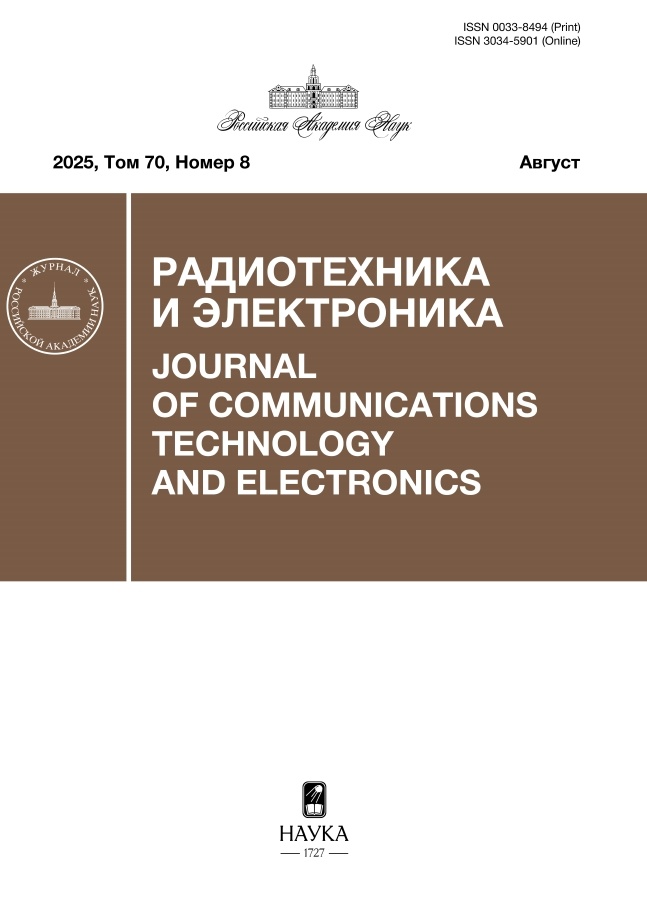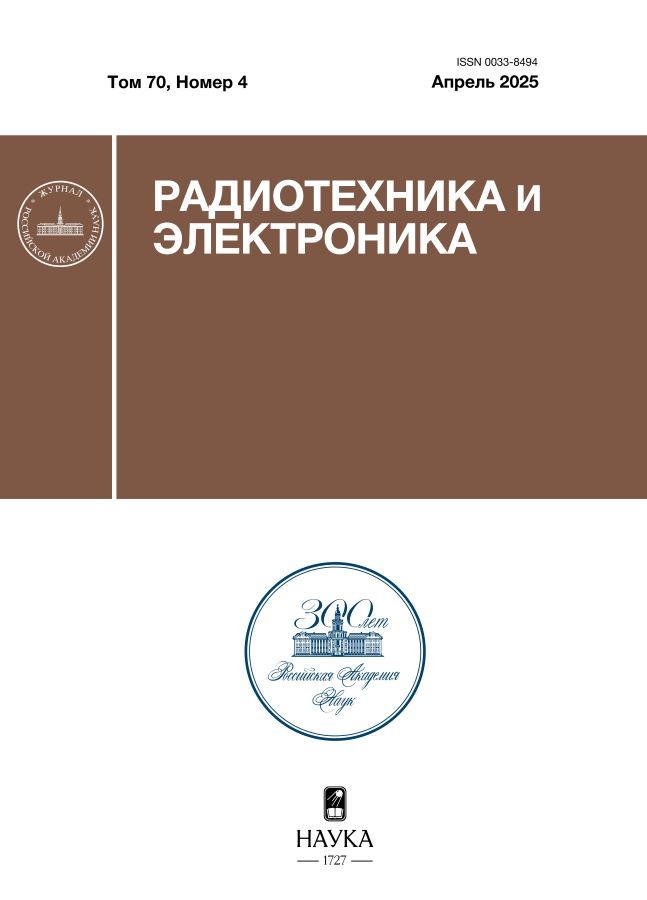Электрозвуковые сдвиговые волны в щелевой структуре двух пьезоэлектриков
- Авторы: Вилков Е.А.1, Никитов С.А.2,3,4
-
Учреждения:
- Фрязинский филиал института радиотехники и электроники им. В.А. Котельникова РАН
- Институт радиотехники и электроники им. В.А. Котельникова РАН
- Московский физико-технический институт (национальный исследовательский университет)
- Саратовский национальный исследовательский государственный университет им. Н.Г. Чернышевского
- Выпуск: Том 70, № 4 (2025)
- Страницы: 332-347
- Раздел: К 70-ЛЕТИЮ С.А. НИКИТОВА
- URL: https://vietnamjournal.ru/0033-8494/article/view/687450
- DOI: https://doi.org/10.31857/S0033849425040028
- EDN: https://elibrary.ru/FSTDKV
- ID: 687450
Цитировать
Полный текст
Аннотация
Представлены результаты работ, в которых рассмотрены дисперсионные свойства электрозвуковых волн в щелевой структуре двух пьезоэлектриков. В частности, показано, что при наличии разности скоростей сдвиговых волн в пьезоэлектриках отсутствуют чисто симметричные и антисимметричные моды, а коэффициенты граничной локализации сдвиговой волны будут значительно отличаться. Установлено, что при определенном равном уровне потерь и усиления (PT-симметричная структура) двух одинаковых пьезоэлектриков класса симметрии 6 происходит пересечение симметричной и антисимметричной мод. Точка пересечения определяет особую точку PT-симметричной структуры. Учет неодинакового уровня потерь и усиления в пьезоэлектриках приводит в спектре сдвиговых волн либо к пересечению, либо к касанию, либо к сближению двух мод в точке их вырождения (особой точке). Как и в случае чисто PT-симметричной структуры, частотная зависимость амплитуды в исключительной точке квази PT-симметричной структуры (при достаточно небольшой разнице в уровнях потерь и усиления) обладает очень узким пиком, что открывает возможность создания сверхчувствительных датчиков на их основе.
Ключевые слова
Полный текст
Об авторах
Е. А. Вилков
Фрязинский филиал института радиотехники и электроники им. В.А. Котельникова РАН
Автор, ответственный за переписку.
Email: e-vilkov@yandex.ru
Россия, пл. Введенского, 1, Фрязино, Московская обл.
С. А. Никитов
Институт радиотехники и электроники им. В.А. Котельникова РАН; Московский физико-технический институт (национальный исследовательский университет); Саратовский национальный исследовательский государственный университет им. Н.Г. Чернышевского
Email: e-vilkov@yandex.ru
Лаборатория «Метаматериалы» Саратовского национального исследовательского государственного университета им. Н.Г. Чернышевского
Россия, ул. Моховая, 11, стр. 7, Москва, 125009; Институтский пер. 9, Долгопрудный, Московская обл., 141701; ул. Большая Казачья, 112а, корп. 8, Саратов, 410012Список литературы
- Miao H., Li F. // Ultrasonics. 2021. V. 114. Article No. 106355.
- Xua D., Caia F., Chena M. et al. // Ultrasonics. 2019. V. 93. P. 18.
- Peng X., He W., Xin F. et al. // Ultrasonics. 2020. V. 108. Article No. 106205.
- Zeng L., Zhang J., Liu Y. et al. // Ultrasonics. 2019. V. 96. P. 34.
- Балакирев М.К., Гилинский И.А. Волны в пьезокристаллах. Новосибирск: Наука, 1982.
- Пустовойт В.И. // Успехи физ. наук. 1969. Т. 97. № 2. С. 257.
- Avetisyan A.S. Electroacoustic Waves in Piezoelectric Layered Composites. Cham: Springer, 2023.
- Гуляев Ю.В., Плесский В.П. // Акуст. журн. 1977. Т. 23. № 5. С. 716.
- Балакирев М.К., Горчаков А.В. // ФТТ. 1977. Т. 19. № 2. С. 613.
- Пятаков П.А. // Акуст. журн. 2001. Т. 47. № 6. С. 836.
- Двоешерстов М.Ю., Чередник В.И., Петров С.Г., Чириманов А.П. // Акуст. журн. 2004. Т. 50. № 6. С. 776.
- Guliy O., Zaitsev B., Teplykh A. et аl. // Sensors. 2021. V. 21. P. 1822.
- Гулий О.И., Зайцев Б.Д., Ларионова О.С. и др. // Антибиотики и химиотерапия. 2021. V. 66. № 1–2. С. 12.
- Borodina I.A., Zaitsev B.D., Burygin G.L., Guliy O.I. // Sensors and Actuators B: Chemical. 2018. V. 268. P. 217.
- Borodina I.A., Zaitsev B.D., Teplykh A.A. // Ultrasonics. 2018. V. 82. P. 39.
- Inone М., Moritake H., Toda К., Yoshino К. // Japan. J. Appl. Phys. 2000. V. 39. Pt. 1. № 9B. P. 5632.
- Rico A.J., Martin S.J. // Appl. Phys. Lett. 1987. V. 50. № 21. P. 1474.
- Kondoh J., Saito K., Shiokawa S., Suzuki H. // Japan. J. Appl. Phys. 1996. V. 35. Pt. 1. № 5B. P. 3093.
- Aнисимкин В.И., Анисимкин И.В. // РЭ. 2000. Т. 45. № 7. С. 293.
- Aфанасьев М.С., Вилков Е.А., Бышевский-Конопко О.А., Чучева Г.В. // РЭ. 2024. Т. 69. № 4. С. 394.
- Li X.F., Yang J.S. // Sensors and Actuators. 2006. V. 132A. № 2. P. 472.
- Yang J.S. // Mathematics and Mechanics of Solids. 2006. V. 11. № 5. P. 451.
- Bender C.M., Boettcher S. // Phys. Rev. Lett. 1998. V. 80. № 24. P. 5243.
- El-Ganainy R., Makris K.G., Christodoulides D.N., Musslimani Z.H. // Opt. Lett. 2007. V. 32. № 17. P. 2632.
- Зябловский А.А., Виноградов А.П., Пухов А.А. и др. // Успехи физ. наук. 2014. Т. 184. № 11. С. 1177.
- Schindler J., Lin Z., Lee J.M. et al. // J. Phys. A: Math. Theor. 2012. V. 45. P. 444029.
- Deymier P. Acoustic Metamaterials and Phononic Crystals. Berlin: Springer, 2013.
- Galda A., Vinokur V.M. // Phys. Rev. B. 2016. V. 94. № 2. P. 020408.
- Liu H., Sun D., Zhang C. et al. // Science Advanced. 2019. V. 5. № 11. Article No. eaax9144.
- Miri M.-A., Alù A. // Science. 2019. V. 363. № 6422. Article No. aar7709.
- Doronin I.V., Zyablovsky A.A., Andrianov E.S. et al. // Phys. Rev. A. 2019. V. 100. № 2. P. 021801(R).
- Wang X.-G., Guo G.-H., Berakdar L. // Nature Commun. 2020. V. 11. Article No. 5663.
- Guo A., Salamo G.J., Duchesne D. et al. // Phys. Rev. Lett. 2009. V. 103. № 9. P. 093902.
- Yang Y., Jia H., Bi. Y. et al. // Phys. Rev. Appl. 2019. V. 12. № 3. P. 034040.
- Bилков Е.А., Бышевский-Конопко О.А., Темная О.С. и др. // Письма в ЖТФ. 2022. Т. 48. № 24. С. 38.
- Vilkov E.A., Byshevski-Konopko O.A., Kalyabin D.V., Nikitov S.A. // J. Phys. Cond. Matter. 2023. V. 35. № 43. P. 435001.
- Bилков Е.А., Бышевский-Конопко О.А., Калябин Д.В., Никитов С.А. // Акуст. журн. 2024. № 5. С. 663.
- Соснин А.С., Струков Б.А. Введение в сегнетоэлектричество. М.: Высш. шк., 1970.
- Акустические кристаллы: Справочник / Под ред. М. П. Шаскольской. М.: Наука, 1982.
Дополнительные файлы





















